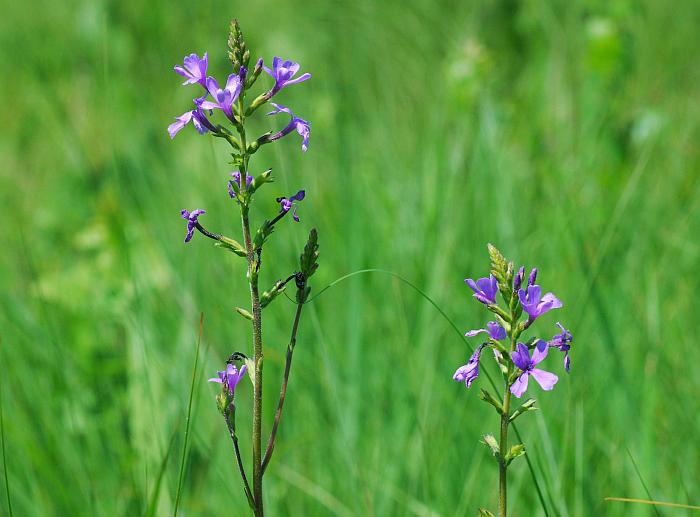Buchnera americana L.
Blue Hearts

Native
CC = 10
CW = 3
MOC = 28
© SRTurner
Buchnera americana L.Blue Hearts | |
 |
Native CC = 10 CW = 3 MOC = 28 |
© SRTurner |
|
Family - Orobanchaceae Habit - Annual, hemiparasitic forb. Stems - Erect, to 90 cm, solitary or a few, usually unbranched, often purplish near tip, moderately to densely pubescent with short, stiff, upward-angled, nonglandular, pustular-based hairs, roughened to the touch.
Leaves - Opposite, simple, sessile. Blades to 6 cm, lanceolate to ovate, with few coarse teeth, acute, with 3 conspicuous main veins arising from base of blade, the surfaces moderately to densely pubescent with short, stiff, upward-angled, nonglandular, pustular-based hairs, roughened to the touch.
Inflorescence - Open to moderately dense, terminal spikes to 15 cm, with small bracts shorter than the calyces, these 5 mm long, lanceolate to narrowly ovate, roughened-hairy, the flowers paired at the nodes, stalkless; bractlets 2 per flower, 3 mm long, shorter than the bracts, linear to narrowly lanceolate. Cleistogamous flowers absent.
Flowers - Calyces 5-lobed, 10-nerved, 6-9 mm long, tubular at flowering, becoming distended and somewhat urn-shaped at fruiting, moderately roughened and antrorse-hairy on the outer surface, actinomorphic, the lobes much shorter than the tube, triangular. Corollas 5-lobed, 15-23 mm long, weakly zygomorphic, trumpet-shaped, deep or dark purple to bluish purple, the tube hairy on the inner surface, roughened-hairy on the outer surface, the throat densely hairy, the lobes shorter than the tube, abruptly spreading, their outer surface hairy, especially toward the base, the inner surface glabrous or sparsely hairy, the margins glabrous. Largest corolla lobes to 9 mm long, 3-4 mm broad, often notched at apex. Stamens 4, fused to base of corolla tube, with the filaments of 2 lengths, short, not exserted, the anthers appearing to have only 1 sac, narrowly lanceolate, yellow, glabrous. Style relatively short and stout, not exserted, the stigma club-shaped, unlobed. Ovary superior, cylindric, green, glabrous, 3 mm long. Placentation free central, ovules numerous.
Fruits - Capsules 6-8 mm long, asymmetrically oblong-ovoid (appearing somewhat pouched on 1 side at the base), usually slightly flattened, glabrous. Seeds 0.6-0.8 mm long, angular, irregularly oblong-ellipsoid to oblong-obconic, the surface with a fine network of low ridges and narrow, elongate areolae, brown to dark brown.
Flowering - June - September. Habitat - Prairies and limestone glades. Origin - Native to U.S. Lookalikes - None close. Other info. - This species is found in the southern half of Missouri, but is relatively uncommon. Its U.S. distribution is restricted mostly to the southeastern quadrant of the country, though it also ranges into Canada. In flower it is easy to identify, with no close mimics. The flowers are quite showy and the plant is worthy of cultivation. It grows well from seed. Photographs taken at Taberville Prairie, MO., 6-16-05; also at Victoria Glade, Jefferson County, MO, 6-21-2009 and 8-30-2015 (SRTurner). |